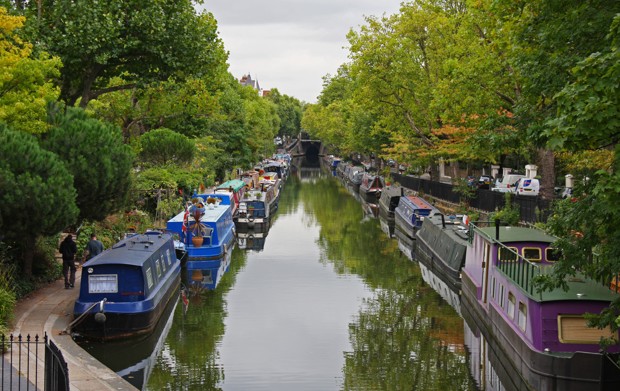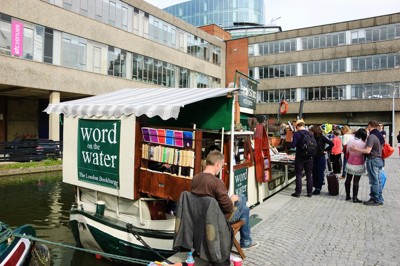 Read the original article on CityLab.
Read the original article on CityLab.
One weekend afternoon about a month after I moved aboard a canal boat in London, there was a rap-rap-rap on the wood and metal paneling of my front door. I had left it partly open to let in the breeze, and a woman was peeking in like a tentative cat.
“Excuse me, do you live around here?” she asked. We were docked at Little Venice, a busy hub for tourists just a short walk north of Hyde Park. I said yes. She seemed confused, and pointing toward nearby Paddington, she asked again, “You mean, you live around here?” I noticed two more faces peeking around the door.
“No,” I said, pointing to the floor in the middle of my living room. “I live here.”
The visitors—Finnish tourists—had been touring London’s canals. I invited them in, happy to let them take photos, and in an attempt to impress them with the modernity of boat living, told them that the Internet onboard (tethered to my phone) was faster than in any of the three London flats I’d lived in.
Unimpressed, they wanted to know how many knots I could tie.
None, I told them. The only thing I knew about boats when I moved onboard in August was that I wanted to live on one.
The U.K. capital has more than 100 miles of waterways (not including the Thames River). Over the past four years, the number of people living on boats that ply them has risen by more than 50 percent.
In March 2015, there were 3,255 narrow boats on London waterways, about two-thirds of them permanently docked in small marinas around the city. The other 1,225—up from 638 in March 2011—travel up and down the canals and dock where they please for up to two weeks at a time, mostly along the stretch of canals north of and roughly parallel to the Thames.

Two factors are behind the mini-boom: housing costs in central London spiraling out of reach, and recent technological advances like solar panels, LED lights, and mobile Internet connections that allow people to live aboard with modern conveniences.
My boat is a floating one-bedroom flat with a deck, living room, and kitchen at the front; a bathroom and shower in the middle; and a bedroom at the back. A tank in the bow provides water for the kitchen sink and shower, and two adjacent gas tanks power the boiler and kitchen stove. I refill them every four to six weeks, with water from one of the service stations run by the Canal and River Trust, and with gas from a commercial boat cruising the city.
Electricity comes from the boat’s central battery. To use it, I have to flip on a switch, and then switch it off when I’m done to avoid draining the battery (a disaster). Solar panels on my top deck—the same deck where I like to sunbathe—recharge the battery in the daytime, and even soak up some power on London’s many rainy days.
One of my current neighbors, Fergus Carr, an architect, says his first encounter with canal boats was in 2012, when he and his partner chanced upon the Canalway Cavalcade, a yearly festival in Little Venice, where the Grand Union Canal and Regent’s Canal meet.
“We were just on a walk, because we lived nearby in North London, and we came upon all these people on boats and just thought, ‘This is incredible.’”
They began investigating houseboat living after a visit to a friend’s narrow boat and decided to try it. They bought their boat for £16,000 (about $24,000) in southern England this summer and sailed it to the capital, crossing the quick-flowing, tidal Thames during the journey—a feat of planning, since narrow boats can only reach a speed of about 4 kilometers (2.5 miles) an hour and can’t travel against the current. They spend £20 per month on gas and diesel and their license fees are £745 a year.
Carr’s parents, who had discouraged him from the plan (“Just save up for a flat!”), are now in the process of moving aboard their own boat.
Built during the Industrial Revolution to transport coal and timber around the city, and made obsolete by the rise of the railways and then roads, London’s canals suffered a long decline over the 20th century. By mid-century, many were in disrepair and overflowing with garbage. A few closed, and a cleanup effort in the 1970s dredged those that remained. But it failed to revive the canals’ reputation.
As recently as a decade ago, some sections were “considered no-go areas,” according to Jon Privett. Privett moved into his first boat in 2000, when there were only “about 40 boats in London without [permanent] moorings.” The waterways weren’t very busy, but were fun, he says, because all the boat residents knew each other.

“Now there’s a kind of safety in numbers,” he says. “And it’s a lot more like living in a house.” (A house where you switch off the water between rinsing each plate when doing dishes, I’d add.)
In 2011, Privett opened London’s first—and only—bookstore on a boat, called Word on the Water. On my first weekend after arriving in the city last November, my partner and I walked the west end of London’s canals while looking for a place to live. We came across a barge overflowing with books, a saxophonist playing on the upper deck. Smoke curled out from the boat’s chimney. In the back, two children read near the fireplace. It was warm inside, and I wanted to stay.
Officially, we are borrowing a friend’s boat for the next year … and paying him for the privilege, about 40 percent of the cost of a similar apartment in the area. To legally rent a boat out, an owner must have a permanent mooring (scarce in the city) and a particular type of business license. As a result, there isn’t a real rental market; most live-aboards own their crafts.

The Canal and River Trust advises people not to see boats as a cheap housing alternative, warning of “hidden costs and maintenance jobs.” For me, these include never using my onboard fridge (it drains the battery), putting a lot of time and effort into heating, and moving twice a month.
About a third of London’s canal boats, including ours, run on “continuous cruising licenses,” requiring them to move every two weeks so they don’t monopolize access to the canals. I’ve cruised from West London through Notting Hill, past waterside cafes and underneath the London Zoo’s bird enclosures, along opulent Primrose Hill mansions and touristy Camden Market. I’ve docked yards away from concerts I’m attending in East London.
I’ve also docked three boats abreast for several days at a time, and had to climb across two boats to get to my own. I’ve run out of dry wood on one of the first cold days of the winter, and cursed everything, including my own lack of preparation.
“Our advice,” says Fran Read, the Trust’s national press officer, “is that you should only live on a boat if you love the lifestyle—not because you think it will save you money.”
